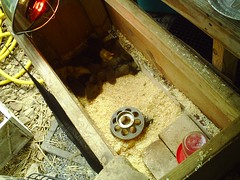
The big news this week was the arrival of our fourteen female ducklings. Shipped to us the day they hatched, we received the little peeping balls of fuzz with coos and cries of, "Awww, those are the cutest things ever!" (I believe that last one was uttered mostly by yours truly.)
I didn't know much of anything about caring for ducklings when they got here. Another staff member, KMO, has had experience with baby chickens, so I assumed he would be the primary "duck mamma." I didn't count on the fact that I would fall head over heels in love with the little sweeties and want to make sure they have every chance of surviving to becoming adult egg-laying, tick-munching members of the ETC family. In addition to my tendency to go dewy eyed in the presence of the ducklings, KMO left this morning for a ten day trip. While he's away, I'll be sleeping in the bedroom next to the attached greenhouse (their current home) to respond to any cries of distress in the night, and making sure they have plenty of fresh water and food during the day.
So, in preparation for my duck mamma duties, I turned to the internet for guidance. What I got was a bunch of conflicting advice about bedding and swimming lessons, but pretty consistent views on food and heat. Here's what we're doing at the ETC.
- Housing & Bedding: The babies are housed in a wooden box without a lid. During the night, we put a rectangle of metal screening on the top and weigh it down with bricks to prevent mice or rats getting it. Their original bedding was straw, but it was quickly soaked and soiled. We changed to a commercial pine shaving bedding. It still gets very wet and soiled, but exec pt for right next to the water dish, the dampness and feces seem to be confined to the top layer. This makes it easier to clean on a daily basis. Some websites on duckling care warned against pine shavings due to the duck's tendency to try to eat it. Ours did try it out at first, but quickly spit out most of what they tasted, deeming it "icky." They've had the pine bedding for two days, and are all still alive and kicking.
- Heat: The ducklings' home is in a greenhouse that maintains a daytime temp of high 70's to mid 80's depending on cloud cover. We've got a heat lamp clamped to the side of the box, and keep an eye on their behavior to determine whether it's too hot. From what I understand, they should be at a temp of about 90-95 degrees, gradually decreasing it after about 10-ish days.
- Food & Water: We're feeding them a non-medicated 20% starter/grower chick feed. Its small crumbles are perfect for little bills. According to the bag, we should switch to the pellet form at about ten weeks. The food is served in a purchased UFO-shaped feeder with holes cut out of the top. The perforated lid allows the ducklings access to the food without it spilling all over the place. The water has been a learning experience. They drink (and spill) a lot of water. The water dish consists of a quart ball jar with the dish part screwed on top. It's turned upside down and gravity feeds the water into the dish as the ducks drink it. Ducks are dabblers, and drop food in the water and sprinkle it all over their bedding in the blink of an eye. We check the water at least once an hour, and refill the jar many times a day. I've taken to putting the water dish up on a platform of a couple of smooth bricks, so that the ducklings don't stand in the wet bedding while trying to drink.
- Swimming Lessons: Nothing yet, so far. I've read conflicting advice, saying that they can have supervised swimming in shallow water from day one, or that they shouldn't be in water until their true feathers grow in at about 9-12 weeks.
That's pretty much it right now. On their first day here, I took a little video of their cuteness and posted it to youtube. Here are the little ones in their cinematic debut: Cute Baby Ducks.
No comments:
Post a Comment